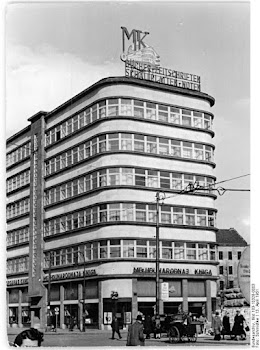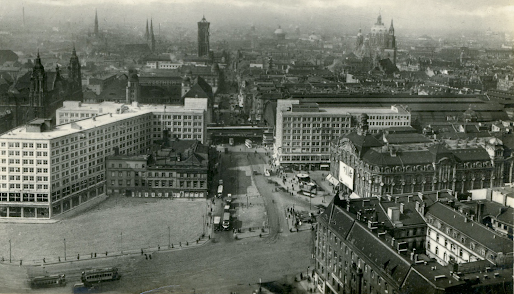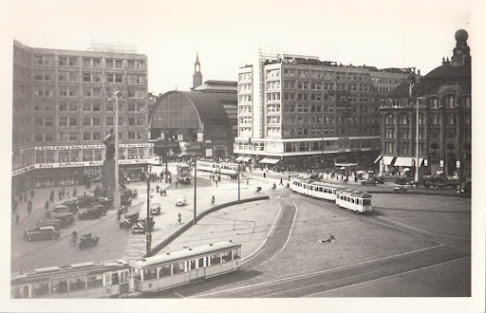 |
| By artist Jeanne Mammen |
Browsing through guide-books from the Weimar era, I notice that Alexanderplatz is seldom mentioned. It was not considered an appropriate area for tourists to visit, not for the average tourist anyway. For one thing, there were no hotels there. The Grand Hotel Alexanderplatz was the only such big establishment and it closed already in 1919, the same year when Spartakists broke in and occupied the nearby Police Department. There were as a matter of fact other hotels, but of a very basic kind and often used by prostitutes and their clients.
Despite its importance as a center of traffic and commerce, Alexanderplatz couldn’t shake its image as a somewhat suspect place, and even the more settled neighborhoods around were labeled poor by other Berliners.
"Transformation" is a word that one finds all the time when reading about Alex. Also Potsdamer Platz was a bustling traffic centre, but once it got its final shape, it stopped changing. Not so Alex. Alex was in perpetual movement, always subject to new urban redesigning, always found too small, too cramped for the increasing masses of people which went daily through it and needing thus expansion, widening, enlargement. And, as Franz Hessel noted, this never-ending transformation attracted an often down-and-out population which was also transient. And the bulldozers and drills which every now and then laid bare the guts of the streets in order to dig tunnels for new subway lines and new subway stations, had as a side result holes, trenches which were used as temporary shelters by homeless, and also for the sex-traffic which thrived in this area.
 |
| Map from HistoMap, with some of the streets mentioned in the text |
"In the popular imagination", states Peter Jelavich in his book about Döblin’s novel and Weimar culture, "the Alexanderplatz and environs comprised a variety of contradictory images." On the one hand, it represented modernity, with its department stores like Tietz and Wertheim, its cinemas, its hectic traffic. It was considered the American part of the capital, because of its rapid transformation and because of modern constructions like Berolinahaus, Alexanderhaus (built by an American company) and Minolhaus. On the other hand, Alexanderplatz meant poorer sectors of the population: proletarians, part-time workers, unemployed, criminals, prostitutes but also Jewish immigrants from Eastern Europe.
There was a special kind of tourists who came to Alex, not in spite of its bad name but attracted by it. They were avid of thrilling experiences, eager to take a closer look at "dark Berlin", "sinful Berlin", after having seen the royal palace, the Kurfürstendamm, bought postcards and followed one of the popular Elite-tours which showed them the Museum Island, the Wilhelmstrasse with the ministries, and maybe the Haus Vaterland with its renowned musical shows from all over the world.
Those tourists were likely to buy Curt Moreck’s "Guide to wicked Berlin" from 1931, recently republished in its German version by the publishing house BTB. Moreck takes a detached look at vice. He records it, informs and recommends. He warns the tourists, most likely from the provinces or from other German cities – the book is in German – that truly dangerous places do not abound any longer. There were once in Berlin bars frequented by criminals, but that belongs now to the legend, he says. Real criminals, for instance the associations known as Ringvereinen, a sort of maffias, were discreet and avoided bars frequented by petty criminals or pimps. Those bars, for instance those around Stettiner Banhof (half an hour walk from Alex) were not especially dangerous, but tourists were well advised to keep an eye on their possesions. The patrons were, besides crooks and pimps, prostitutes of both sexes.
Then there was the prostitution. Many bars in Alex’ area were favoured by pimps and their girls, especially those on Münzstrasse, Mulackstrasse, Schönhauerstrasse, Weinmeisterstrasse. Some of those streets were in the ill-famed Scheunenviertel. The girls weren’t expected to consume, says Moreck, it was enough that they brought customers to the establishment who would have a beer or two even if they didn’t engage the services of the girl. If they did, there were kneipen that provided spaces where couples could enjoy the necessary privacy. The spaces could be quite narrow, more like berths, provided by Café Quetsch in Schönhauerstrasse.
Austrian writer Joseph Roth gives his impressions of some kneipen in the area in articles published in 1921. "There is this long fellow Max, a plasterer (but only during the day), there is Berta, Grete, whose real name is Margot, Else (without a surname) and finally Anny, the Silesian in contrast to Bavarian Anny, it is advisable not to mix them up; Bavarian Anny has her stand at Schönhauser Tor and rarely comes to this area. Besides, she only got out a week ago. Out of jail, she claims, but nobody believes her. As Max rightly says, she came in fact from the hospital but is ashamed to say so."
 |
| Cover of the original edition of Moreck's book |
There was Reeselokal. Light is red in that bar, as all the lamps have red paper napkins around them. There is an orchestra without, though the first violinist kind of conducts the others with his eyes. Reese is a place you go to, others are places where you just are, says Roth. You usually go there after 8 p.m. And the music plays well. Small scandals do happen at Reese, but they are always matters of honor. It's never about money, it's about women.
The Albert-Keller, on the other hand, on Weinmeisterstraße is quiet and without music, continues Roth, and also not bathed in red. The owner is a Romanian immigrant called Albert. There are guests so regular that they pick up their mail here. Albert-Keller reminds Roth somehow of a literary café, "like the fact that one can sleep a whole afternoon there." A guy had been sleeping for four hours when Roth arrived, his nose pressed against a table. At his side, a girl with flashy earrings watchs him sleeping. "Therese, another girl, is blond and completely oxidized. I accompany her to her stand at Alex."
Then there is Cafe Dalles, once called "Angel Palace", at Neue Schönhauser 13, with regulars like Kirsch, the burglar, Willy from Tegel and Fritz the apache. No more angels in this palace, except a blonde girl with combed curls, sitting on someone's knees because she’s wearing new stockings on and when one has new stockings it is absolutely necessary to show them. She’s having a sandwich and a glass of Alash (a sweet cumin liqueur). There is a roulette table too, in this ancient dwelling of angels. One feels transported to "The Blue Angel" and Marlene Dietrich.
At the Tippelkneipe, on the Linienstrasse, Roth meets the "Klopp brothers", a couple of beggars so frozen that not even ten African summers could drive out their cold. It is certainly not easy to be a Klopp brother, concludes Roth. They are playing cards. Fred and Karlchen are no beggars, and as a matter of fact it is very nice of them to honor the place with their presence. They are not needy, they earn two hundred marks a day working in the West as lightbulb specialists. Electrical technicians like them do not ask about the origin of the lightbulbs they buy. Electrical technicians are not curious.
Max Fürst, a German author who was a friend of the lawyer Hans Litten, concentrates on one specific café, from whose window one could see the Alexanderplatz. Early in the morning, guys working at the nearby central food market were still there, enjoying a last beer before going to bed after their night work. Then came the businessmen and the shop girls for breakfast, being followed by the businessmen who hold their meetings at the café, in time replaced by various people for a quick lunch. Then there was a pause until a band started playing in the afternoon, when coffee and cake with whipped cream were eagerly eaten during some hours. After dinner, the audience changed again, young people came with their friends, some regulars sat at their tables until around 11 a.m. when the band packed up. Now the whores and their clients slowly took over the place. It was a constant coming and going. After 1 a.m. only the girls were still there, waiting for their pimps to settle accounts with them.
But not everything was burglars and pimps. After all, most of the East’s inhabitants were honest working people. Curt Moreck tells about Krug zum Grünen Kranze, a restaurant, beer hall and ballroom by Alex. A place which tourists could visit without risk, if they were wise enough not to ask local girls to dance; males at Grünen Kranze did not appreciate strangers, whether from Hamburg or from West Berlin, who didn’t keep to their own kind.
Moreck mentions also ballrooms where the girls (but not the gentlemen) wore bathing suits. These were ordinary girls from the East Side : shop attendants, seamstresses, even secretaries, hoping for some fun in their free time. The best bathing suit was given a prize, and in order to choose it, they had to be closely inspected, which the girls wearing them didn’t object to. Some followed suit with the gentlemen after the dance.
In places like Grünen Kranze, Rehkeller, Alt-Mexiko, one could see people with sinister looking faces, but they were usually not criminals, says Moreck. Alt-Mexiko, close to Alex and mentioned in Alfred Döblin’s famous novel, had an exotic atmosphere, with palm-trees (not real ones like in Adlon Hotel) and other exotic items. The bar had a price list for broken glasses and dishes.
There was a small café where personnel impersonated famous people : you were greated by Neville Chamberlain, president Hindenburg took your order, Harold Lloyd served you and the bill was brought by Aristide Briand who, being the French foreign minister, often sent demand for payments to Berlin (Moreck’s hint to the heavy war reparations that France imposed on Germany after the First World War).
And let's not forget a truly famous venue: Residenz Kasino, better known as Resi, on Blumenstrasse 10, just some blocks from Alex.
Part of the information above comes from "Der Berliner Alexanderplatz", by Gernot Jochheim.

























